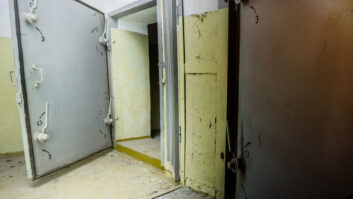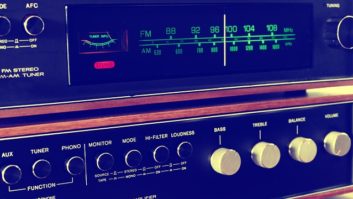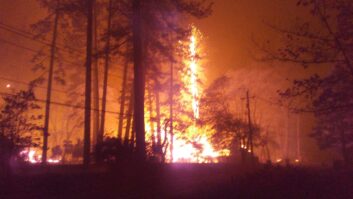Scrap metal prices have jumped the past six months and overall metal theft alerts have increased dramatically in the first part of this year compared to 2009.
But anecdotal evidence suggests these trends haven’t translated to an increase in copper thefts from radio stations.

Dave Chambers, who works in engineering & IT for Clear Channel in Orlando, monitors transmitter site surveillance cameras. Broadcast tower sites are like gold to copper thieves. Particularly attractive are AM transmission facilities that often feature extensive copper grounding systems. But engineering leaders for several radio groups said that while copper theft is still occurring, it’s not as dramatic as it has been.
These executives think that’s mostly attributable to the theft deterrents many broadcasters have put in place since 2008 when metals prices soared and thefts skyrocketed. A spate of brazen copper thefts from broadcast sites nationwide — which included HVAC units, copper buss bars, copper grounding straps, coax, conduit and antennas — forced broadcasters to take action, industry observers said.
Broadcaster anti-theft efforts include motion-sensitive remote surveillance, security alarms, better lighting and additional fencing at remote transmission sites.
While other metals are at risk of being stolen, copper seems to be the main quarry of thieves at telecommunication sites nationwide. Its filching has gained notoriety from media coverage of the occasional high-profile theft.
For example, KMBC(TV) in Kansas City was knocked off the air in April when vandals cut away and stole a large section of 2-inch conduit from the side of a transmitter building. The tubing was part of the transmitter’s cooling system, according to reports in the Kansas City Star.
Recycled copper averaged $3.50 per pound in early May. Not since 2008, when copper hit a record $4 a pound, have prices been this high for scrap copper and other non-ferrous metals. Copper prices plunged in late 2008 as the worldwide economy tanked but apparently climbed of late thanks to the improving economy and an increase in demand from markets like China and India.
Radio industry observers say thieves often cause property damage that far exceeds the actual value of the copper stolen. In fact, scrap recyclers typically pay thieves a rate that is significantly lower than market value.
Theft alerts up

Chief Engineer Bob Stroupe at Clear Channel’s KPRC(AM) in Houston adjusts cameras. Aside from the occasional copper theft report, “the bad guys appear to have retreated, at least for now. We’ve added more periodic fence inspections,” said Marty Hadfield, corporate engineer for Alpha Broadcasting, which owns six radio stations in Portland, Ore. “It’s been nothing like what (the radio industry) saw in 2008.”
That rash of copper thefts spurred lawmakers in Washington to propose the Copper Theft Prevention Act of 2008. The bill, which failed to gain support in that year’s lame duck session of Congress, called for better record-keeping by copper recyclers and prohibited cash payments of more than $500 at one time. The bill would have provided for a civil penalty of up to $10,000. Industry observers said it is unclear whether such legislation may someday be re-introduced.
The Institute of Scrap Recycling Industries has launched a website — www.scraptheftalert.com — aimed at tracking metal thefts. The group, which consists of companies that process and broker scrap commodities, said the number of theft alerts through the site have increased.
“There was a total of 643 alerts in 2009, while so far this year we are already at 525 alerts,” said Gary Bush, director of materials theft prevention for ISRI. “That could be in part attributable to more law enforcement becoming familiar with the site, too.”
By ISRI’s count, 47 states have metal purchase record-keeping laws, which require scrap recyclers to log the name and address of sellers. Only North Dakota, Iowa and Alaska do not have such laws. Especially vulnerable to copper theft are telecommunication sites, utility companies and railroads, Bush said.
Tarring copper
“We haven’t had any issues with copper theft in the past year that I know of,” said Milford Smith, vice president of engineering for Greater Media, which has 23 radio stations. “These things seem to be driven by the state of the economy and the price of copper, but we have stepped up efforts to prevent illegal activity.”
‘Make Them Uncomfortable’
While larger broadcasters have the resources to combat metal theft, small-market broadcasters often are at high risk because of they lack the resources to add layers of defense at transmitter facilities.
“The object is to make it as difficult as possible for thieves to strike,” said Gary Bush of the Institute of Scrap Recycling Industries.
“You want to slow them down and make them uncomfortable. It costs money for silent sensors and surveillance cameras, but adding signage that says ‘this area under video surveillance’ doesn’t cost much and the bad guys won’t know that it isn’t.”
Something else small broadcasters can do is to contact their local law enforcement agencies and ask them for after-hours patrols, Bush added.
“They will normally do it as a courtesy if they have the manpower to do so on the roads.”
Finally, he said, small broadcasters can consider a low-cost alarm system, which “would pay for itself if it prevents even one copper theft.” Smith said Greater Media lost more than $40,000 in copper strap, wire and screen to thieves from an AM transmitter site near Philadelphia in 2008.
Clear Channel, with its 850 or so stations, has instituted policies aimed at minimizing copper theft while providing for the safety of employees, said Gil Garcia, technical director for Clear Channel, Austin.
“Each market is very different, with some markets seemingly more vulnerable to copper theft; but we haven’t had many issues lately corporate wide, which tells me what we are doing is working,” he said.
Garcia also serves as national disaster coordinator for the company. He said Clear Channel has resorted to tarring copper in some markets as a means to make it a less desirable target for bandits.
“I have even looked at materials to place a specific chemical DNA on copper so it can be identified at scrap metal recyclers, but that was really cost-prohibitive. There is also a spray you can use to cause a horrendous stink on copper to scare away thieves.”
Another option is painting exposed copper with grease and graphite, said Dave Remund, vice president of engineering for Townsquare Media, formerly Regent Communications Inc., which owns 63 radio stations. “Not only does it make detection harder, but once (thieves) touch it they soon realize how much of a mess it makes and usually leave to find an easier target,” he said.
Townsquare Media had not suffered a copper loss due to vandalism since 2008 as of May.
Citadel has gone so far as considering using some tin-plated materials at broadcast installations hoping to lower scrap value to thieves, said Martin Stabbert, vice president of engineering for Citadel Communications and its 228 radio stations.












